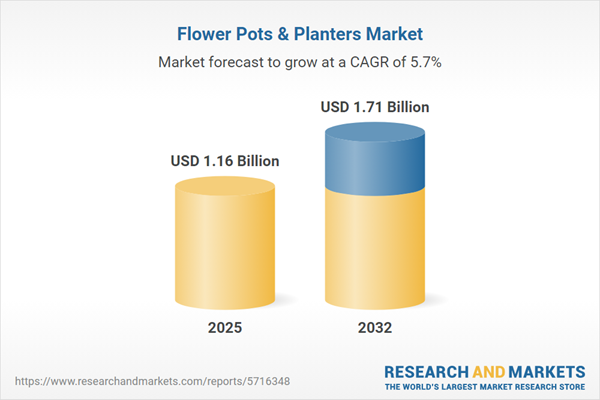Speak directly to the analyst to clarify any post sales queries you may have.
The flower pots and planters market is entering a period of transformation, driven by shifting consumer preferences, digital advancement, and sustainability imperatives. Decision-makers navigating this environment must balance evolving design, technology, and supply chain complexities to achieve sustained growth and differentiation.
Market Snapshot: Flower Pots and Planters Market Size and Outlook
The flower pots and planters market grew from USD 1.10 billion in 2024 to USD 1.16 billion in 2025. It is projected to expand at a CAGR of 5.66%, with revenues anticipated to reach USD 1.71 billion by 2032. Underpinning this growth are increasing consumer investments in indoor and outdoor aesthetics, rising adoption of innovative materials, and a marked shift toward digital sales channels.
Scope & Segmentation
- Material: Ceramic, Metal, Plastic, Terracotta
- Style: Modern, Rustic, Traditional
- Distribution Channels: Offline (Florists, Specialty Garden Centers, Supermarkets & Hypermarkets), Online (E-commerce Platforms, Manufacturer Websites)
- End Use: Commercial (Hotels, Offices, Restaurants), Institutional (Municipal Projects, Parks), Residential
- Geographic Coverage: Americas (North America: United States, Canada, Mexico; Latin America: Brazil, Argentina, Chile, Colombia, Peru), Europe, Middle East & Africa (Europe: United Kingdom, Germany, France, Russia, Italy, Spain, Netherlands, Sweden, Poland, Switzerland; Middle East: United Arab Emirates, Saudi Arabia, Qatar, Turkey, Israel; Africa: South Africa, Nigeria, Egypt, Kenya), Asia-Pacific (China, India, Japan, Australia, South Korea, Indonesia, Thailand, Malaysia, Singapore, Taiwan)
- Companies Analyzed: ADO URBAN FURNITURE, S.L.; Ashley Furniture Industries, LLC; Anmol Fibres; AnushikA Agri Products; Atech SAS; Bamaplast S.r.l.; BENITO URBAN, S.L.; Garant by The AMES Companies, Inc.; H.Smith Plastics Ltd.; Hawthorne Gardening Company; Inter IKEA Systems B.V.; Palmetto Planters; Planters Unlimited; Quanzhou Neweco High Polymer Material Co., LTD.; Samarth Industries; Stefanplast S.p.A.; Central Garden & Pet Company; EarthBox by Novelty Manufacturing Co.; Elho BV; Fiskars Corporation; Keter Group BV; Pöppelmann GmbH & Co. KG; SCHEURICH GmbH & Co. KG; Veradek, LLC; Westland Horticulture Limited
Key Takeaways: Market Dynamics and Strategic Insights
- Shifting consumer attitudes favor sustainable, recyclable materials, prompting manufacturers to prioritize bio-based composites, recycled plastics, and environmentally responsible ceramics.
- Digital distribution, personalization, and immersive e-commerce experiences are optimizing customer acquisition and retention strategies, especially for B2B buyers seeking tailored and scalable planter solutions.
- Sector innovation is accelerating through material science advancements, including modular planters, self-watering systems, and IoT-enabled products that support plant health and user convenience.
- Omnichannel strategies that unite the immediacy of brick-and-mortar stores with seamless digital touchpoints are reshaping the competitive landscape and supporting complex buying journeys.
- Strategic alliances—between planter producers, plant suppliers, and landscape architects—are unlocking bundled solutions and new commercial opportunities across institutional and commercial segments.
Tariff Impact: Navigating Supply Chain and Cost Pressures
- The 2025 United States tariff framework has elevated input costs for ceramics and metals, driving producers to diversify sourcing and invest in operational efficiencies.
- Companies are mitigating tariff-related volatility by exploring nearshoring, alternative supply corridors, and localized production strategies for greater resilience and cost control.
- Material innovation—including the development of lightweight composites and recycled polymers—is gaining importance in addressing both cost pressures and evolving sustainability standards.
Methodology & Data Sources
This report utilizes a robust methodology that combines primary interviews with executives, channel partners, and industry experts, along with extensive secondary research of trade publications, regulatory filings, and company reports. Analytical frameworks and validation with expert panels enhance data reliability and actionable insights.
Why This Report Matters: Empowering Strategic Decisions
- Equips senior leaders with market intelligence to optimize portfolio management, navigate evolving end-user demands, and align with environmental regulations.
- Informs proactive responses to supply chain disruptions and tariff impacts through strategic sourcing and technology adoption.
- Supports targeted growth initiatives and competitive positioning across diversified regional and sector segments within the flower pots and planters market.
Conclusion
The flower pots and planters industry requires strategic agility as it responds to changing consumer expectations, sustainability demands, and channel shifts. This report supports confident decision-making through data-backed insights and practical recommendations for growth.
Additional Product Information:
- Purchase of this report includes 1 year online access with quarterly updates.
- This report can be updated on request. Please contact our Customer Experience team using the Ask a Question widget on our website.
Table of Contents
3. Executive Summary
4. Market Overview
7. Cumulative Impact of Artificial Intelligence 2025
Companies Mentioned
The companies profiled in this Flower Pots & Planters market report include:- ADO URBAN FURNITURE, S.L.
- Ashley Furniture Industries, LLC
- Anmol Fibres
- AnushikA Agri Products
- Atech SAS
- Bamaplast S.r.l.
- BENITO URBAN, S.L.
- Garant by The AMES Companies, Inc.
- H.Smith Plastics Ltd.
- Hawthorne Gardening Company
- Inter IKEA Systems B.V.
- Palmetto Planters
- Planters Unlimited
- Quanzhou Neweco High Polymer Material Co., LTD.
- Samarth Industries
- Stefanplast S.p.A.
- Central Garden & Pet Company
- EarthBox by Novelty Manufacturing Co.
- Elho BV
- Fiskars Corporation
- Keter Group BV
- Pöppelmann GmbH & Co. KG
- SCHEURICH GmbH & Co. KG
- Veradek, LLC
- Westland Horticulture Limited
Table Information
| Report Attribute | Details |
|---|---|
| No. of Pages | 183 |
| Published | November 2025 |
| Forecast Period | 2025 - 2032 |
| Estimated Market Value ( USD | $ 1.16 Billion |
| Forecasted Market Value ( USD | $ 1.71 Billion |
| Compound Annual Growth Rate | 5.6% |
| Regions Covered | Global |
| No. of Companies Mentioned | 26 |









